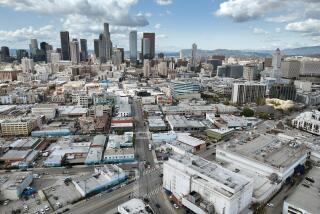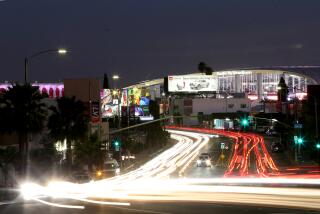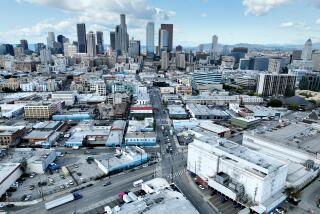Norwalk Eyes More Diversity as Route for New Redevelopment Efforts
- Share via
NORWALK — Having kindled about $130 million in new commercial construction during the past three years, the city’s redevelopment efforts appear headed down new paths.
Past projections suggest that the amount of commercial space either built or planned in Norwalk’s first redevelopment zone are about all the central city area can profitably absorb.
While planners anticipate demand for more stores in portions of the new redevelopment district stretching into the southern reaches of the city, they are also eyeing a more diverse mix of projects.
Talk of New Projects
There is talk of building housing, attracting light industry and fixing up existing residences and businesses.
“Our initial goal was to generate sales tax, and I think we’ve been very successful in doing that,” said Redevelopment Director Michael J. Wagner, commenting on the push for commercial ventures to enrich city coffers. “Now the City Council wants to stand back for a moment, take a breath, and see what directions they should go in.”
With nearly 500,000 square feet of new commercial development completed or in the pipeline for the first redevelopment district, the city has attracted new shopping centers and stores and aided the expansion of existing enterprises.
But, Wagner said, “You can only go so far,” especially since the city has neither the people nor the dollars to support major regional shopping magnets.
“I don’t think there are going to be any more Price Club deals,” he added. The discount, warehouse-style grocery store lured from Cerritos annually pours $400,000 in sales taxes into Norwalk’s treasury.
Two-and-a-half years after ground was broken for the city’s first redevelopment project, only a few blocks remain unspoken for in the initial 600-acre redevelopment zone. The zone encompasses the Civic Center area, Norwalk Square, and the Firestone Boulevard corridor. Citing waning developer interest in building more stores there, Wagner’s staff has broached other possible uses.
Such uses might include what Wagner called speciality commercial--such as free-standing bowling alleys or health clubs--or residential developments for the elderly or convalescents. At the behest of the City Council, Norwalk’s standing Blue-Ribbon Committee is also beginning a study of development alternatives for the second project area. The newly formed, 374-acre district spans 11 scattered sub-areas covering the major intersections of Studebaker Road, along with Excelsior High School and portions of the Pioneer Avenue corridor.
The committee is planning hearings to gauge public sentiment on what should be done in the new zone, and at this point has little notion of what it will recommend, said Ralph Pacheco, committee chairman.
“I think essentially what the city is saying, is we’re keeping our options open,” Pacheco commented.
Developers Best Equipped
That’s certainly what City Council members are doing.
“I think the developers are the best equipped to say what is going to fly and what isn’t,” Councilman Marcial (Rod) Rodriguez said.
“The developers are the ones who will spend millions of dollars; they will pretty much dictate to us what they want to build,” Rodriguez said, adding that, from his conversations with them , he perceives continued interest in both commercial and residential projects.
Councilwoman Grace Napolitano said it is time the city started concentrating on rehabilitating existing businesses and houses. She also believes the city needs new single family homes to cater to upwardly mobile families that now have to move out of Norwalk when they’re ready for bigger and better housing. Mayor Margaret (Peg) Nelson sees room for both additional commercial and residential development.
Citing city-commissioned economic studies of the second redevelopment district, Wagner said there’s a potential demand for about 300 new residential units, including apartments, single family residences, and condominiums; 200 to 300 motel rooms; about 1 million square feet of renovated and new commercial space, and industrial space.
Still, such projections, reflecting the changing character of Norwalk redevelopment, will only serve as a backdrop to the decisions that will guide the area’s revitalization.
Other Considerations
Other considerations are at work as well.
Because the buildings in the second project area are not as old as those in the first redevelopment district, they lend themselves to rehabilitation rather than razing, which cleared the way for new construction in the central zone. Recognizing that many small businessmen are wary of being driven out by the redevelopment push, the city is likely to emphasis renovation efforts that will allow the small businessmen to stay put.
Although the Norwalk-La Mirada Unified School District last week pulled Excelsior High School, a key redevelopment site, off the market, city officials seem optimistic that the 38-acre parcel will figure into revitilization plans.
Planners also appear unruffled by the city-wide moratorium on new apartment construction recently imposed by the City Council. Concern over a couple of specific projects led to the moratorium, not general antipathy to all new apartment construction in Norwalk, Planning Director Don Rouly said. In effect until mid-1988, the moratorium is intended to give the city a chance to review its multifamily zoning, and, if necessary, adjust it before proceeding with new apartment construction.
More to Read
Sign up for Essential California
The most important California stories and recommendations in your inbox every morning.
You may occasionally receive promotional content from the Los Angeles Times.














